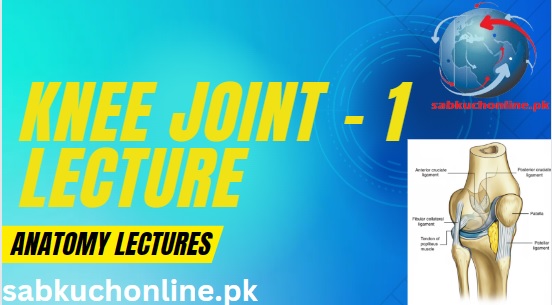Learning Objectives
•Describe the articulation, type, capsule, ligaments, synovial membrane, nerve supply, blood supply, relations, and movements related to the knee joint
•Bursae related to knee joint and point out those which communicate with the joint cavity
•Structures responsible for stability of knee joint

Knee Joint – Type

•Largest synovial joint – modified hinge variety
•Joint b/w femur and tibia (fibula is not involved)
Knee Joint – Type
Compound joint includes:
1.Two condylar (hinge) joints b/w condyles of femur and tibia
2.Plane gliding joint b/w patella and patellar surface of femur
Movements:
1.Flexion & extension
2.Small amount of rotation in flexed position

Articulation
•Above – rounded condyles (lateral & medial) of femur
•Below – tibial condyles (tibial plateau) & the cartilaginous menisci
•Front – lower end of femur & patella

Articulation
•Articular surface of patella is divided by a vertical ridge into a large lateral & a small medial surface
•All articular surfaces are covered with hyaline cartilage
•Lateral and medial articular surfaces of femur & tibia are asymmetrical
•Lateral & medial menisci – almost circular and oval respectively


Capsule
•Attached to margins of articular surfaces, sides & posterior aspect
•Posteriorly: proximal margins of femoral condyles, intercondylar fossa (strengthened by a tendinous expansion of semimembranosus – oblique popliteal ligament) & margins of tibial condyles (attachment to lateral tibial condyle interrupted by an aperture for popliteus tendon)
•Sides: to the margins of femur and tibial condyles, strengthened by expansions of vastus lateralis and medialis tendons
•Anteriorly: sides of patellar ligament but deficient above the level of patella permitting synovial membrane to outpouch beneath the quadriceps tendon forming suprapatellar bursa
Anatomy of the Knee joint

Ligaments
Extracapsular Ligaments
•Ligamentum Patellae
•Lateral Collateral Ligament
•Medial Collateral Ligament
•Oblique Popliteal Ligament
Intracapsular Ligaments
•Anterior Cruciate Ligament
•Posterior Cruciate Ligament
•Menisci

Ligamentum Patellae
•Attached above: Lower border of patella
•Attached below: Tuberosity of Tibia
•Continuation of Quadriceps Femoris Tendon

Collateral Ligaments
Lateral (Fibular) Collateral
•Cordlike
•Above: lateral condyle of femur
•Below: head of the fibula
•Not attached to capsule & has no connection with lateral meniscus
•Bursa b/w ligament & capsule
Medial (Tibial) Collateral
Flat, triangular band
Above: medial femoral condyle
Below: medial surface of tibial shaft
Posterior apex of ligament blends with capsule; attached to medial meniscus


Oblique Popliteal Ligament
•Expansion of tendon of semimembranosus muscle
•Blends with the capsule at the posterior aspect to strengthen it
•Ascends laterally to intercondylar fossa and lateral femoral condyle


Cruciate Ligaments
•Pair of strong intracapsular (not intrasynovial) ligaments connecting tibia to femur
•
•Cruciate ligaments cross each other like the limbs of X (anterior ligament lying anterolateral to the posterior ligament)
•
•As though they herniate into the synovial membrane from behind so covered from synovial membrane from front & sides but not posteriorly

Anterior Cruciate Ligament
•Attached to the anterior part of the tibial plateau b/w the attachments of the anterior horns of lateral and medial menisci
•Ascends posterolaterally, twisting on itself, and is attached to the posteromedial aspect of the lateral femoral condyle

Posterior Cruciate Ligament
•Stronger, broader, shorter & less oblique
•Attached to a smooth impression on the posterior part of tibial intercondylar area
•Ascends anteromedially and is attached to the anterolateral aspect of the medial femoral condyle

Menisci
•Crescentic discs of fibrocartilage which deepen the articular surfaces & act as cushion b/w the bones
•Lie on & are attached to the tibial plateau via anterior & posterior horns
•Upper surfaces articulate with convex femoral condyles
•Peripheral borders being thicker; attached to the capsule
•Inner borders being thinner & concave
•Peripheral zone is vascularized by capillaries from capsule
Medial Meniscus
•Oval shaped; broader posteriorly
•Anterior horn attached to intercondylar area in front of anterior cruciate ligament
•Posterior horn attached in front of posterior cruciate ligament
•Relatively immobile (firmly attached) owing to the attachment to medial (tibial) collateral ligament

Lateral Meniscus
•More circular; uniform width
•Anterior horn attached behind the anterior cruciate ligament with which it partly blends
•Posterior horn attached in front of the posterior horn of medial meniscus

Synovial Membrane
•Lines the capsule and is attached to the articular margins of femur, tibia & patella but doesn’t cover the menisci

Synovial Membrane
•On the front & above patella, it forms an outpouching called suprapatellar bursa
•At the back, it is elongated downwards deep to popliteus tendon to form popliteal bursa
•Anteriorly, the membrane is separated from the patellar ligament by infrapatellar fat pad, which herniates the membrane into the joint cavity as a pair of fold, alar folds
•Alar folds converge in midline into a single infrapatellar fold


Nerve Supply
Femoral, Common Peroneal & Tibial nerves;
supply anterior, lateral and posterior aspects respectively
Obturator nerve supplies the medial aspect

Blood Supply
•Vasculature: Peri-articular genicular anastomosis
1.Genicular branches of femoral & popliteal arteries
2.Anterior, Posterior branches of anterior tibial recurrent & cicumflex fibular arteries
3.Middle genicular branches of popliteal artery supplying the cruciate ligaments, synovial membrane and peripheral margins of menisci

Bursae
Anteriorly:
1.Suprapatellar bursa – b/w femur & quadriceps femoris
2.Subcutaneous prepatellar bursa – b/w skin & patella
3.Superficial infrapatellar bursa – b/w skin & tibial tuberosity
4.Deep infrapatellar bursa – b/w patellar ligament & upper part of tibia

•2 on sides:
1.Laterally – b/w fibular collateral ligament & biceps femoris tendon
2.Medially – b/w tibial collateral ligament & tendons of sartorius, gracilis & semitendinosus

•4 Posterioly:
1.Popliteus bursa b/w popliteus tendon & lateral tibial condyle
2.Semimembranosus bursa – b/w medial head of gastrocnemius & semimembranosus tendon
3.Anserine
4.Gastrocnemius – deep to medial head of gastrocnemius

Bursae communicating with the joint cavity
1.Suprapatellar bursa
2.Popliteus bursa
3.Anserine bursa
4.Gastrocnemius bursa
Stability of Knee Joint?
- •Extended position of knee is most stable position as the articular surfaces’ contact is maximized
- •Factors contributing
- Bony contours
- Ligaments, surrounding muscles & their tendons
